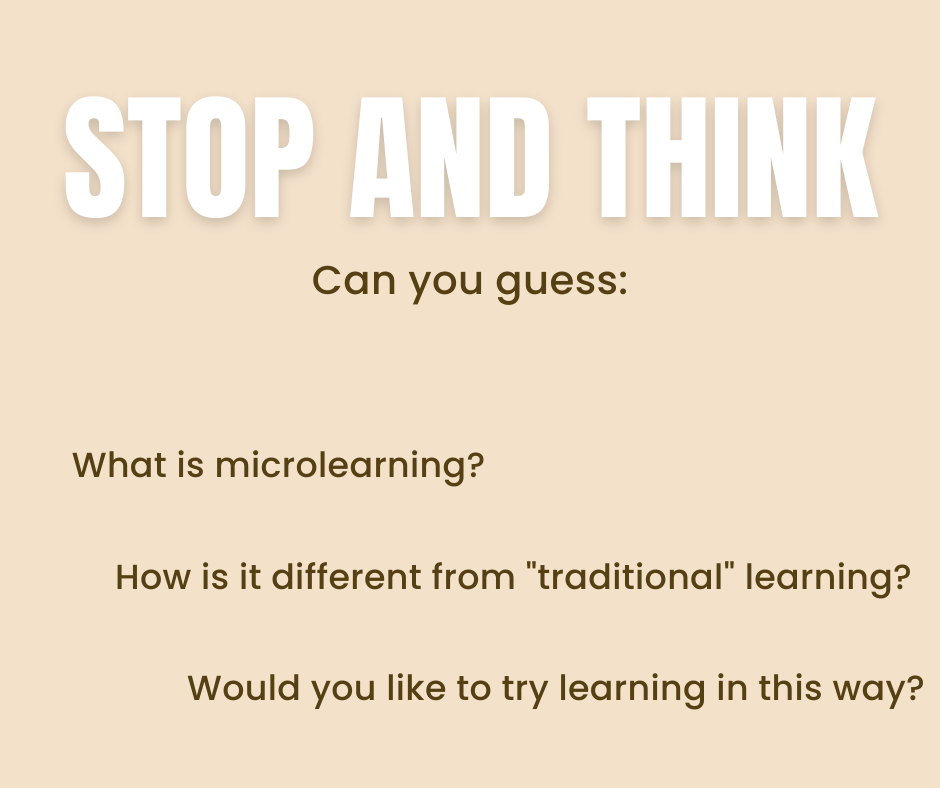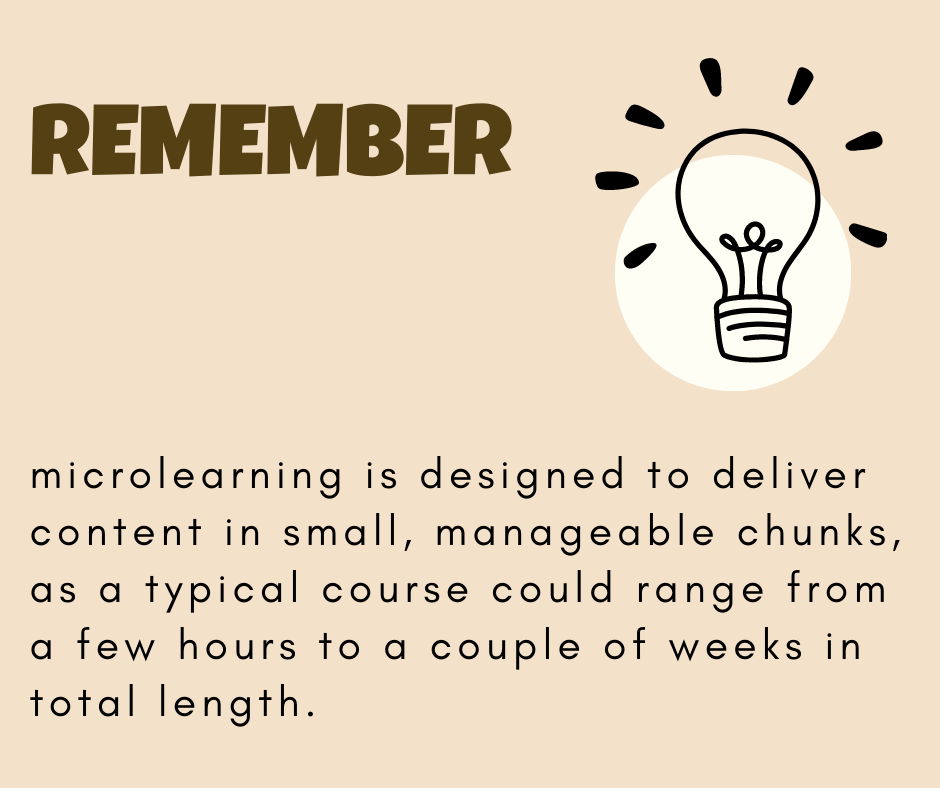What is Microlearning?

The world is constantly changing, and so is the way we learn. Gone are the days when learning was confined to just classrooms and lengthy textbooks. With the rapid evolution of technology, learning styles have also evolved. One such modern learning approach is microlearning. In this blog post, we will explore this learning approach, its benefits, and how it compares to traditional learning designs.

What is Microlearning?
Microlearning is a method of teaching and learning that breaks information down into small, manageable, and easily digestible chunks. Some authors (5) describe it as:
special moments or episodes of learning while dealing with specific tasks or content, and engaging in small but conscious steps.
As such, microlearning can be utilised with a range of pedagogies and types of learning.
These learning nuggets are typically delivered in a digital format and can range from a few seconds to 10-15 minutes in length. Microlearning can take various forms, such as videos, quizzes, flashcards, infographics, and more.
Example of a Microlearning Course
When I was conducting my research on learning strategies, I observed a lecture with university students. As the course aimed to help students understand how different strategies can improve learning, I expected examples, practical work, interactions... What I saw was the professor dictating theory while students took notes. For almost 1.5 hours.
Here are two examples of how the lecture on learning strategies could be transformed into microlearning experiences:
Example 1: Interactive Online Modules
Instead of a single, long lecture (like the one I observed), the content could be divided into several short online modules, each focusing on a specific learning strategy. Each module would be a stand-alone unit and could include a combination of brief video explanations, infographics, and interactive elements such as quizzes or flashcards. Students would be able to access these modules on-demand, allowing them to learn at their own pace and review the material as needed. By breaking the content into smaller, focused segments, students are more likely to engage with and retain the information.
Example 2: Scenario-Based Learning
Let's say that the professor is not a big fan of creating digital content. They could create a series of real-life scenarios or case studies that demonstrate the application of different learning strategies (e.g. planning their learning as one of the metacognitive strategies). Students would be presented with these scenarios during short, focused in-class activities. For each scenario, students would be asked to analyse the situation, identify the most appropriate learning strategy, and discuss their reasoning with peers. This interactive, problem-solving approach would promote a deeper understanding of learning strategies and facilitate knowledge retention.

For instance, a course with six lessons (that could be six different learning strategies), each taking approximately 10-15 minutes to complete, would have a total duration of around 1-1.5 hours. If a learner dedicates 15 minutes per day to the course, they could complete it in about a week. However, the self-paced nature of microlearning allows learners to progress through the course at their own speed, taking more or less time as needed.
Comparing Microlearning to Traditional Learning Designs
- Content delivery: Traditional learning designs, such as lectures and classroom sessions, typically deliver information in bulk, which can overwhelm learners. On the other hand, microlearning breaks information down into smaller pieces, making it easier for learners to digest and retain the content.
- Time commitment: Traditional learning often requires a significant time commitment, while microlearning allows learners to engage with content in short bursts. This makes it an excellent option for busy professionals and individuals with limited time.
- Adaptability: Microlearning can be quickly updated and adapted to suit changing needs and preferences, whereas traditional learning methods can be rigid and slow to change.
- Learning reinforcement: Microlearning allows for frequent and easy repetition in different forms, which is essential for long-term retention. Traditional learning methods may only expose learners to information once or twice, making it difficult to reinforce learning effectively.
- Collaboration and feedback: Microlearning platforms often include social features that encourage collaboration and interaction among learners. This can enhance the learning experience and provide valuable feedback for both learners and educators.
Benefits of Microlearning
There has been a growing body of research on microlearning over the past few years, as its popularity in education and corporate training has increased (check out some interesting studies and reviews listed in Suggested Reading 1-7). Researchers have investigated various aspects of microlearning, such as its effectiveness, design principles, and implementation strategies. Some key findings from this research include the following:
- Improved retention and engagement: Several studies have found that microlearning leads to better information retention and higher engagement levels among learners compared to traditional learning methods. This is attributed to the focused and concise nature of microlearning content, which makes it easier for learners to process and remember the information.
- Just-in-time learning: Research indicates that microlearning is well-suited for just-in-time learning, allowing learners to access specific, relevant information when they need it. This has been shown to increase the effectiveness and efficiency of the learning process.
- Flexibility and accessibility: Microlearning is often delivered through digital platforms, making it easily accessible on various devices and providing learners with the flexibility to learn at their own pace and on their own schedule. This has been found to contribute to higher learner satisfaction and better learning outcomes.
- Personalised learning: Research suggests that microlearning can be tailored to individual learners' needs and preferences, resulting in a more personalised learning experience. This customisation can lead to better learning outcomes and higher levels of learner satisfaction.
- Application in corporate training: Many studies have explored the use of microlearning in corporate training and found it to be an effective method for skill development and knowledge transfer, particularly in industries with rapidly changing content and skills requirements.
While more research is needed to further explore the nuances of microlearning and its long-term effectiveness, the existing body of research suggests that it can be a valuable tool for improving learning outcomes, engagement, and satisfaction in various contexts.
Conclusion
Microlearning is a modern and innovative learning approach that offers numerous benefits over traditional learning designs. It caters to the needs of today's fast-paced and technology-driven society by providing flexible, engaging, and easily accessible learning opportunities. As a result, microlearning is increasingly becoming the preferred method of skill development and education in various sectors. Embrace the change, and give microlearning a try to experience the difference for yourself.
Suggested reading on the topic:
- Bruck, P. A., Motiwalla, L., & Foerster, F. (2012). Mobile Learning with Micro-content: A Framework and Evaluation. In BLED 2012 Proceedings (pp. 15-25).
- Gassler, G., Hug, T., & Glahn, C. (2004). Integrated Micro Learning – An outline of the basic method and first results. Interactive Computer Aided Learning, 4, 1-7.
- Gutierrez, K. (2018). Microlearning: A Strategy for Corporate Training. SHIFT eLearning Blog.
- Hug, T. (2005). Micro learning and narration. Exploring possibilities of utilization of narrations and storytelling for the designing of “micro units” and didactical micro-learning arrangements. In Media in Transition 4: The Work of Stories.
- Hug, T., & Friesen, N. (2007). Outline of a Microlearning Agenda. In Microlearning: Emerging Concepts, Practices and Technologies after e-Learning (pp. 15-36). Innsbruck University Press.
- Nawrot, I., & Doucet, A. (2014). Building Engagement for MOOC Students: Introducing Support for Time Management on Online Learning Platforms. In Proceedings of the 23rd International Conference on World Wide Web (pp. 1077-1082). ACM.
- Raybourn, E. M. (2014). A new paradigm for serious games: Transmedia learning for more effective training and education. Journal of Computational Science, 5(3), pp.471-481



